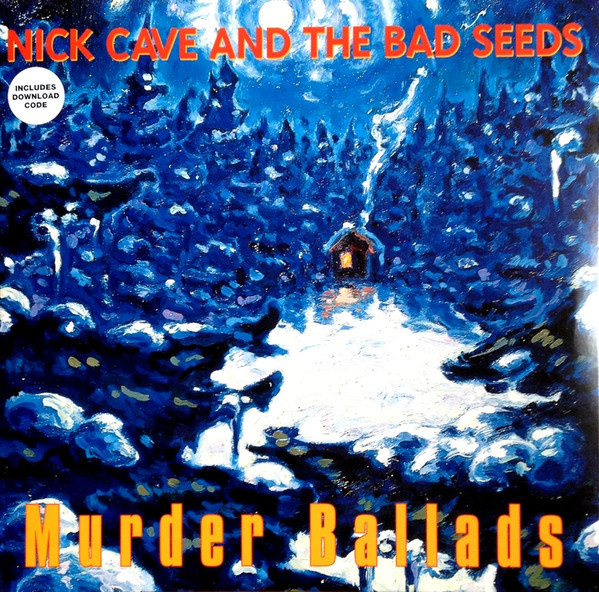
At least 65 men, women, children and animals are gruesomely put to rest on Murder Ballads. Traditional murder ballads—bluesy, romanticised snuff stories, where even the daintiest melody spills blood and bullets—are so quintessentially, definitively Nick Cave, it’s hard to imagine his persona without them. And while, decades later, an album filled with gratuitous assault might generally be seen as unacceptable, if anyone possesses the storytelling prowess to get away with it, it’s him. By the mid-’90s, the Australian artist already had an identity built on lurking in dark, mysterious musical corners and poeticising the macabre, but never quite so intensely or graphically as here. Following on from 1994’s masterful Let Love In, here, love was certainly allowed in, but with a morbid, inevitable catch.
The storytelling on 1996’s Murder Ballads is as brilliant and theatrical as The Bad Seeds’ soundtrack behind it. Cave didn’t just create these exceptionally bloodthirsty killers (nor did he simply revive those in the traditional songs he reimagines, including “Stagger Lee” and “Henry Lee”)—he wholly embodied them. Hear how he snarls on opener “Song of Joy”, portraying a father whose wife and three children are slaughtered by a serial killer (possibly himself) who paints John Milton quotes on the wall in blood. It’s terrifying, and enthralling.
Some characters are quick to anger, such as Stagger Lee, who shoots a bartender in the head four times for mouthing off. Others commit crimes of passion: PJ Harvey portrays a woman who murders Cave’s Henry Lee because he loves another woman. And on the other delicate duet, “Where the Wild Roses Grow”—his biggest hit to date—he woos Kylie Minogue’s Elisa Day before smashing her head in with a rock: “I kissed her goodbye, said, ‘All beauty must die’/And lent down and planted a rose between her teeth.” The serene gothic scene is a stark contrast to “The Kindness of Strangers”, in which we mourn the sad, lonely death of poor Mary Bellows, found “cuffed to the bed, with a rag in her mouth and a bullet in her head”, and the low-slung “Crow Jane”, who avenges her own assault by shooting all 20 male attackers.
One of the album’s most disturbing figures is Lottie, the yellow-haired, green-eyed 14-year-old who wreaks havoc in “The Curse of Millhaven”. Her “they all gotta die” mantra is repeated between stabbings, beheadings, bashings, arson and drownings, depicted with calm glee. When arrested and asked if she feels remorse, she simply replies, “Why of course, there is so much more I could have done if they’d let me!” It makes a fascinating comparison to the 14-minute centrepiece “O’Malley’s Bar”, in which the murderer, after claiming he has no free will, begins experiencing remorse himself. He too is caught and arrested—the only other character to face consequences.
Aside from the philosophical implications that would inform much of this album’s mythology, these two tracks also best show off Cave’s ongoing musical experiments, alongside the influence of then-new Bad Seeds member Warren Ellis. The multi-instrumentalist and composer quickly became Cave’s closest collaborator, and his violins and organs here provided a deeply unique feel that hints at just how crucial he’d be to Cave’s sound over the years and albums to come.
So, what’s it all about? Through these broken people, and all their butchery and pain, what, if anything, are we to learn? Is Cave teaching us about the nature of life, death and love, of grief and mourning, of free will and morality? Or is it all just a twisted glorification of Tarantino-level bloodshed? The only song in which nobody dies is the final track, a warm rendition of Bob Dylan’s “Death Is Not the End”. As though in the closing performance of a musical, the album’s cast—Harvey, Minogue, Cave, Shane MacGowan, The Bad Seeds’ Blixa Bargeld and several more—all chip in to assure us that no matter what happens, death is not the end. It’s an oddly sweet conclusion—and one that only leads to more questions.
Tracklisting
| Position | Title |
|---|---|
| A1 | Song Of Joy |
| A2 | Henry Lee |
| A3 | Lovely Creature |
| A4 | Stagger Lee |
| B5 | Where The Wild Roses Grow |
| B6 | The Curse Of Millhaven |
| B7 | The Kindness Of Strangers |
| B8 | Crow Jane |
| C9 | O’ Malley’s Bar |
| C10 | Death Is Not The End |
Apple Music
Release Images
Release Information
| Key | Value |
|---|---|
| Wikipedia URL | https://en.wikipedia.org/wiki/Murder_Ballads |
| Format | 1× Vinyl LP |
| Label | Mute |
| Catalog Number | LPSEEDS9 |
| Notes | Sides A to C contain music, side D is blank. Track numbers are listed sequentially regardless of side. From front sticker on shrink wrap: Includes download code Contains download card for [url=http://www.discogs.com/release/8065277]FLAC[/url] or [url=http://www.discogs.com/release/8065337]MP3[/url] files. Issued with plain white paper inner sleeves. Recorded in 1993-95 at Atlantis, Sing Sing and Metropolis Studios, Melbourne, Wessex Studios, London and mixed at Metropolis. “Where The Wild Roses Grow” was mixed at Sarm West, London. Mastered at Whitfield Street ℗ 2011 Mute Records Ltd, a BMG Company © 2014 Mute Records Ltd, a BMG Company Runouts are etched |
| Discogs URL | Nick Cave & The Bad Seeds - Murder Ballads |











